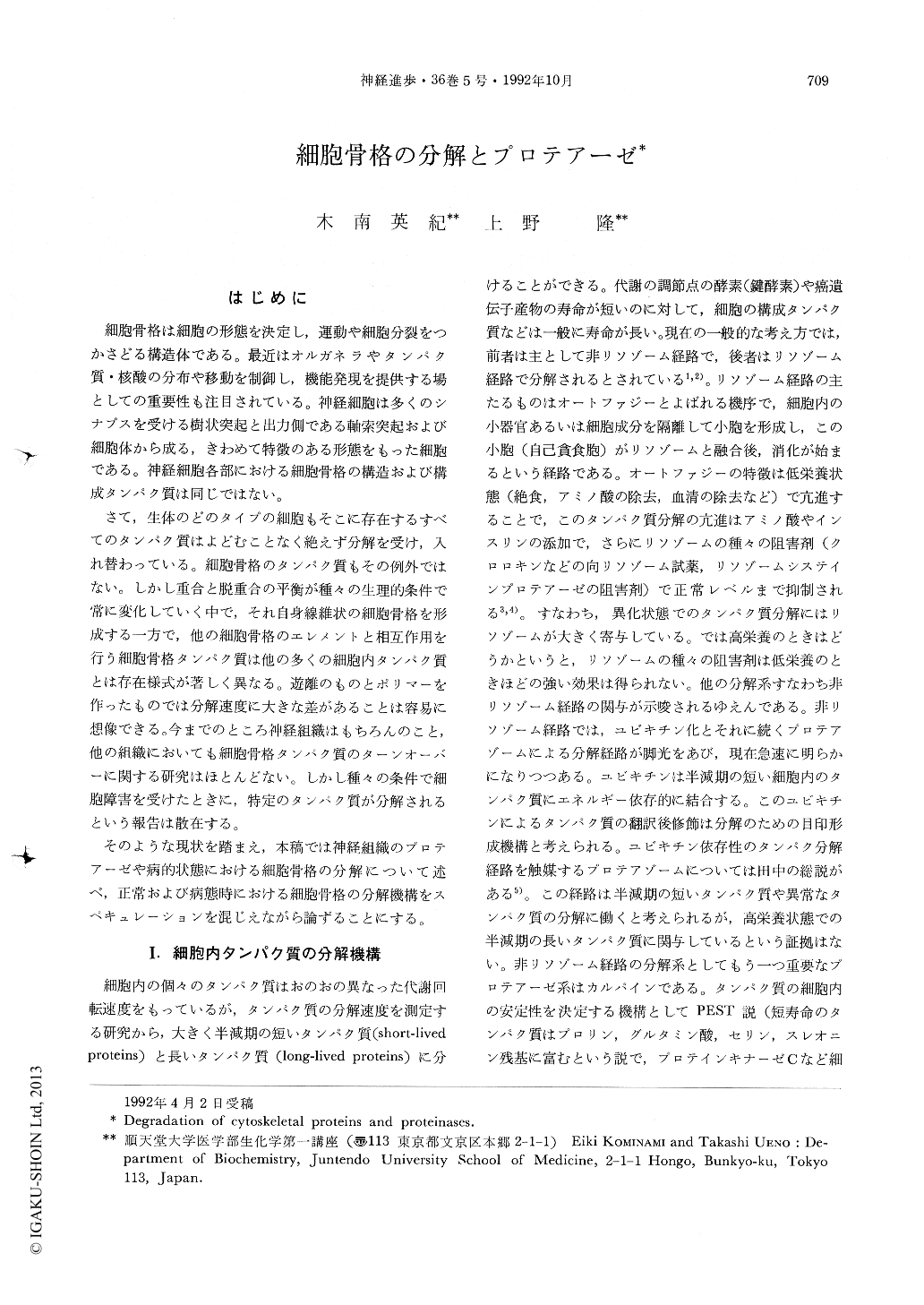Japanese
English
- 有料閲覧
- Abstract 文献概要
- 1ページ目 Look Inside
はじめに
細胞骨格は細胞の形態を決定し,運動や細胞分裂をつかさどる構造体である。最近はオルガネラやタンパク質・核酸の分布や移動を制御し,機能発現を提供する場としての重要性も注目されている。神経細胞は多くのシナプスを受ける樹状突起と出力側である軸索突起および細胞体から成る,きわめて特徴のある形態をもった細胞である。神経細胞各部における細胞骨格の構造および構成タンパク質は同じではない。
さて,生体のどのタイプの細胞もそこに存在するすべてのタンパク質はよどむことなく絶えず分解を受け,入れ替わっている。細胞骨格のタンパク質もその例外ではない。しかし重合と脱重合の平衡が種々の生理的条件で常に変化していく中で,それ自身線維状の細胞骨格を形成する一方で,他の細胞骨格のエレメントと相互作用を行う細胞骨格タンパク質は他の多くの細胞内タンパク質とは存在様式が著しく異なる。遊離のものとポリマーを作ったものでは分解速度に大きな差があることは容易に想像できる。今までのところ神経組織はもちろんのこと,他の組織においても細胞骨格タンパク質のターンオーバーに関する研究はほとんどない。しかし種々の条件で細胞障害を受けたときに,特定のタンパク質が分解されるという報告は散在する。
Three cytoskeletal systems (microfilament, intermediate filament, and microtubule) are known to play an essential role in maintaining structural organization of the cell and conducting various cellular motile activities such as cell division, endocytosis, secretion, organelle transport, etc. In the nerve cell, these cytoskeletons are particularly developed in the dendrite and axon. Parallel arrays of numerous neurofilaments and microtubules run throughout the cytoplasm along the long axis of axon. Micro-tubules comprise principal cytoskeletons in the dendrite, too. Microfilaments are distributed beneath the plasma membrane at presynaptic region, dendrite, and axon. However, they are less conspicuous than neurofilaments and microtubules. It has been demonstrated that actin, tubulin, and neurofilament proteins that are major constituents of these three cytoskeletal systems are synthesized on free ribosomes of the cell body and transported via axonal flow into distal parts of the neuron. In contrast, very little is known on the mechanism by which these cytoskeletal proteins are degraded by cellular proteo-lytic machinery. Since the continuous assembly and disassembly of cytoskeletal proteins occur in various parts of living cells, it is reasonable to assume that free, monomeric cytoskeletal proteins and those incorporated in highly-organized structures of cytoskeleton have different life times because the suscepti-bility to proteases must be different between these two states. In the nerve cell, several factors which affect the stability of cytoskeletons must be considered for understanding life times of cytoskeletal pro-teins. i) Microtubule-associated proteins (MAPs) and various actin-binding proteins which would affect tertiary structure and polymerization-depolymerization cycle, of tubulin and actin. ii) Interaction be-tween cytoskeletons, in particular, between neurofilament and microtubule which is a principal deter-minant in cross-network formation of neuronal cytoskeletons. iii) Covalent modifications such as phos-phorylation and acetylation of cytoskeletal proteins which change the stability of neurofilaments and microtubules.

Copyright © 1992, Igaku-Shoin Ltd. All rights reserved.


